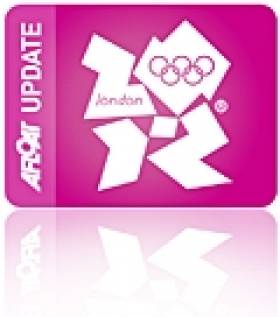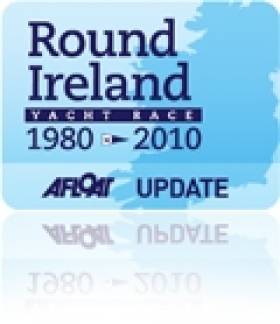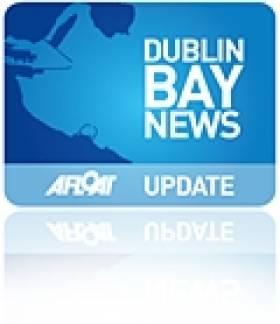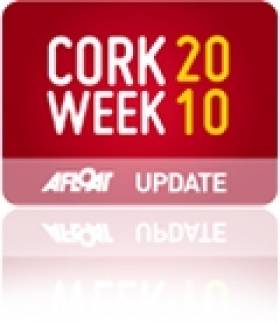Displaying items by tag: sailing
Kinsale Dragon Photos HERE!
Ireland Guaranteed Medal in the Star Class Today (Podcast here)
Ireland is guaranteed a medal today at the British Skandia Sail for Gold regatta in the Star class but Peter O'Leary's clean run in the keelboat this week was not without drama yesterday when his crew Fritjof Kleen slipped overboard 300 metres from the finish line.
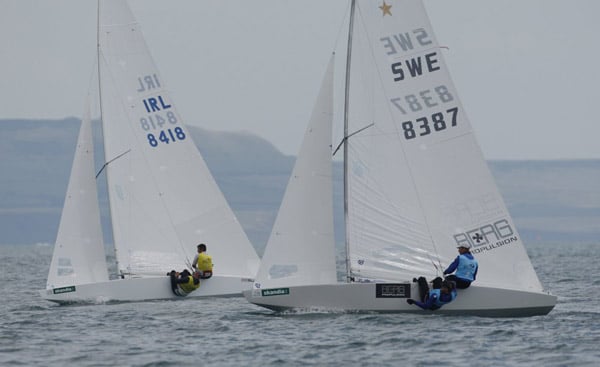
Peter O'Leary and Frithjof Kleen (IRL) against Fredrik Loof and Johan Tillannder (SWE) in the Star class on day 5 of the Skandia Sail for Gold Regatta. Photo: onEdition
ISA Youth Worlds Team Depart for Turkey
The ISA's Youth Worlds team is completing final preparations for the 2010 ISAF Youth World Sailing Championships, which takes place in Istanbul, Turkey from 8th – 17th July 2010. More than 300 young sailors from 60 nations will compete across eight disciplines, of which Ireland will compete in four. The laser sailors travel out over the weekend and will be joined by the 420’s early next week.
The Irish Team:
Matthew O’Dowd (Royal St George YC) -Laser Radial Boy’s One Person Dinghy
Sophie Murphy (Quoile YC) - Laser Radial Girl’s One Person Dinghy
Cian O’Regan (Kinsale YC) and Scott Flanigan (Howth YC)- 420 Boy’s Two Person Dinghy
Jane Butler and Jenny Andreasson (Royal St George YC) - 420 Girl’s Two Person Dinghy
Ross Killian -Team Leader
Arthur Brett -Team Coach
James O’Callaghan ISA Performance Director commented:
“We are extremely excited about this year’s team. Matthew O’Dowd, Jane Butler and Jenny Andreasson have experience of the event last year which counts for a lot. Jane and Jenny recently finished 3rd Youth girls in Kiel regatta so go into the event with lots of confidence.
While Sophie, Cian and Scott are all new to this event they have plenty of international experience which will stand to them.
The ISAF Youth World’s is the pinnacle of a Youth sailor’s career thus far and it is great to see such a committed and talented team representing Ireland.”
O’Callaghan continued: “Ross Killian leads the team and his Olympic experience will no doubt prove invaluable. Arthur Brett from Australia also joins the coaching team and ensures the Laser and Laser Radial will be getting some of the best advice going.”
In 2012 the ISAF Youth Sailing World Championship will take place in Dun Laoghaire, Co Dublin, Ireland.
Leopard 3 Breaks Own 24-Hour Speed Record
The 100ft Canting Keel Maxi Leopard 3 has broken its own record for a 24-hour run, covering 495 nautical miles. The previous record stood at 466.4NM.
The record is in a special category for craft with powered winches, and doesn't come close to some of the other records on boats where humans work the lines by hand.
The monohull record outright is still held by Torben Grael's Ericsson 4 team who covered 596.6nm at an average speed of 24.85 knots during the last Volvo Ocean Race.
Frenchman Thomas Coville blasted through 628.5 nautical miles in 24 hours on his 105ft trimaran Sodebo, averaging 26.2 knots in the process.
But the absolute mac daddy of them all is held by Pascal Bidegorry in his monstrous 131ft trimaran Banque Populaire 5. Bidegorry travelled 908.2 nautical miles in one day, and with an average of 37.84 knots you can only imagine what his top speed was.
The World Sailing Speed Record Council announces the ratification of a new World Record for ICAP Leopard.
Record: Monohull. 24 hours under rule 21.c
Yacht: ICAP Leopard. 100ft Monohull
Name: Mike Slade and 20 crew
Dates: 31st May to the 1st June 2010.
Start time: 05.00; 31/05/10
Finish time: 05.00; 01/06/10
Elapsed time: 24 hours
Distance: 495.1 NM
Average speed: 20.6 kts
Comments: Previous record: 466.4nm 19.4 kts. May 08 Leopard. Mike Slade GBR
Round Ireland Start Photos Here!
Photographer Bob Bateman was in among the fleet for the start of this afternoon's Wicklow's Round Ireland Race. A perfect start in light conditions across Wicklow Bay. His photos below and also on the gallery here.
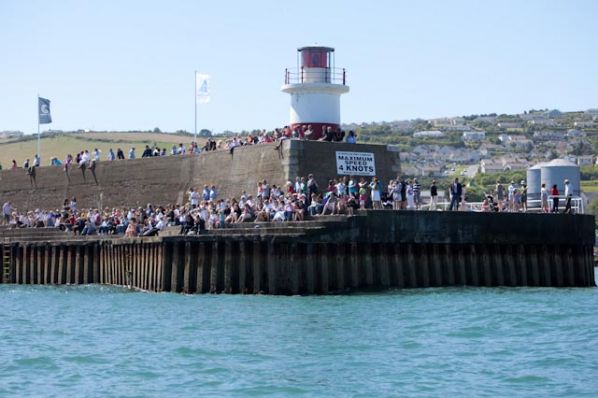
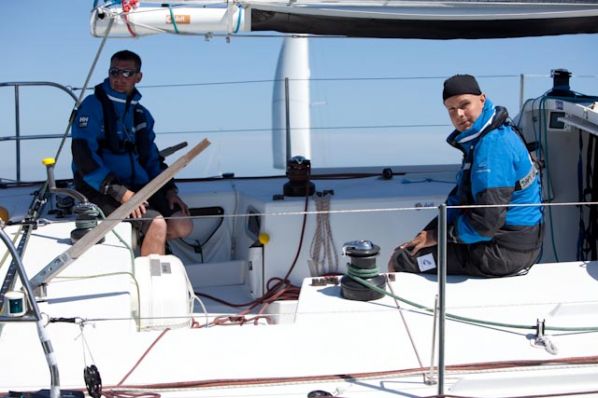

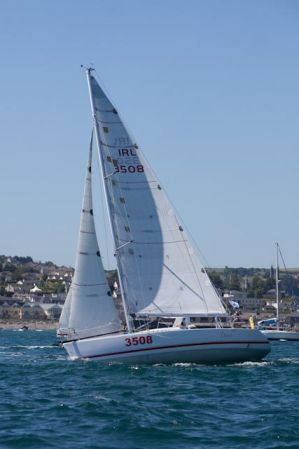
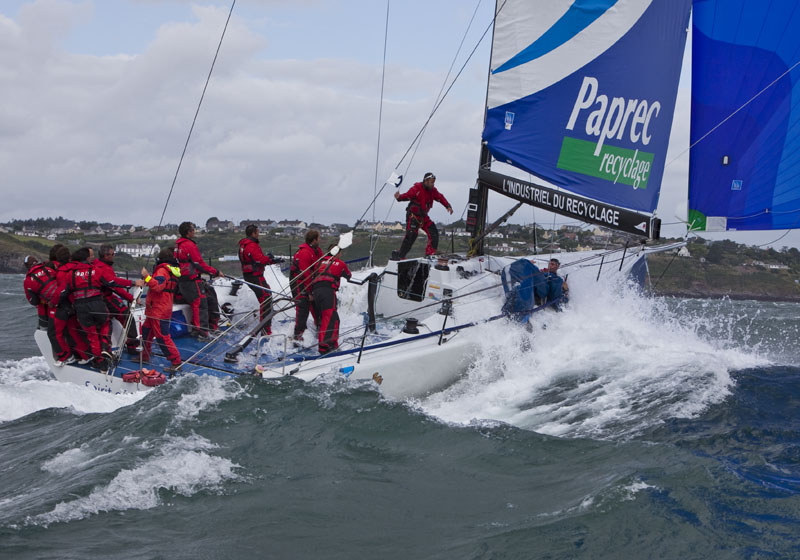
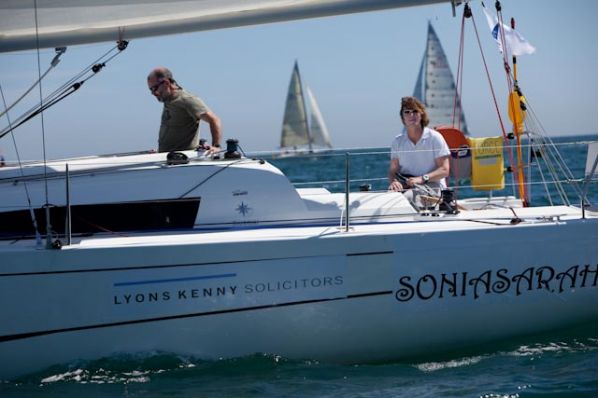

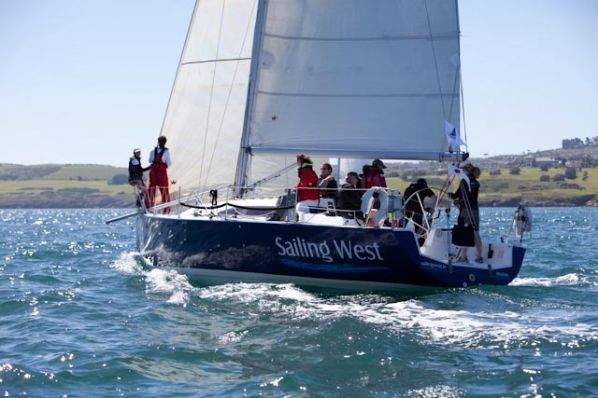

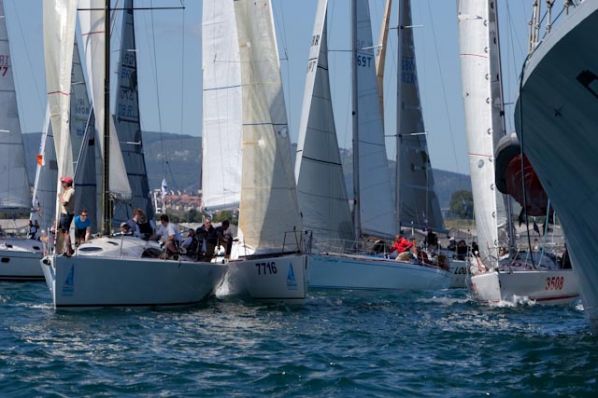
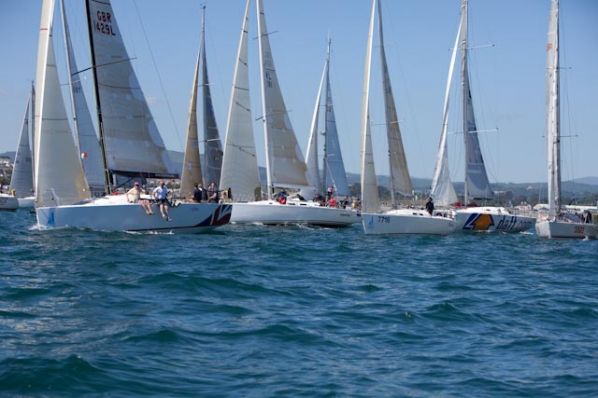
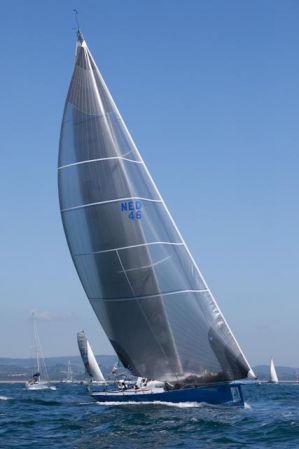
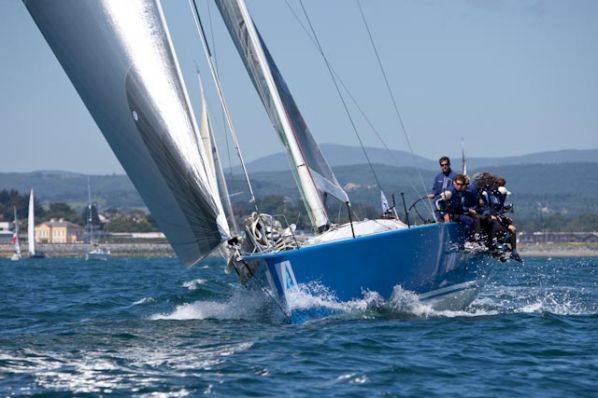
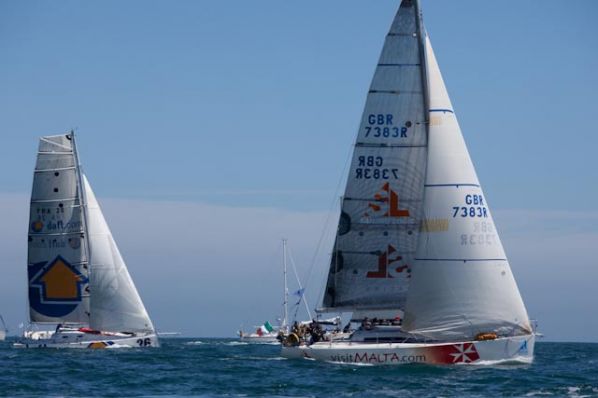
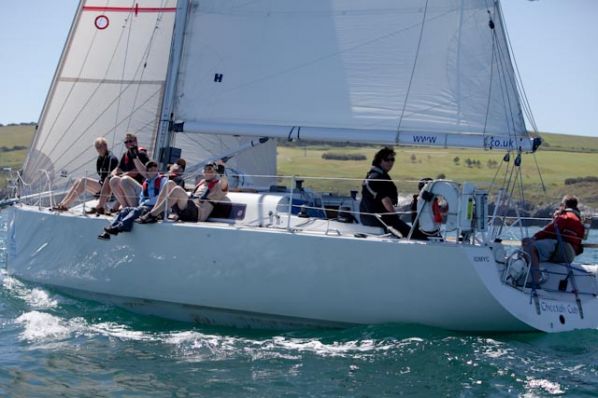
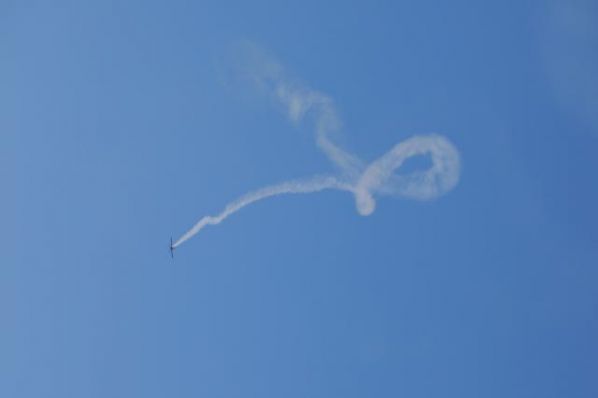
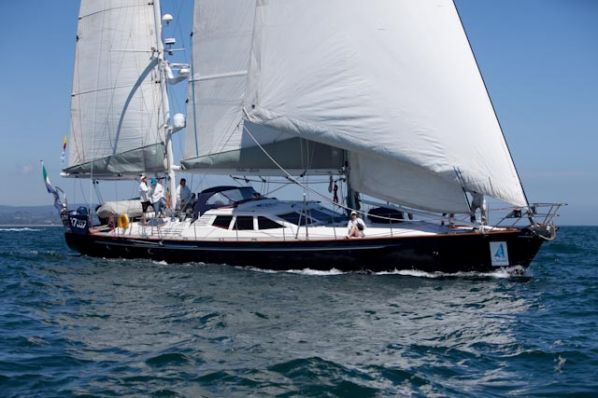
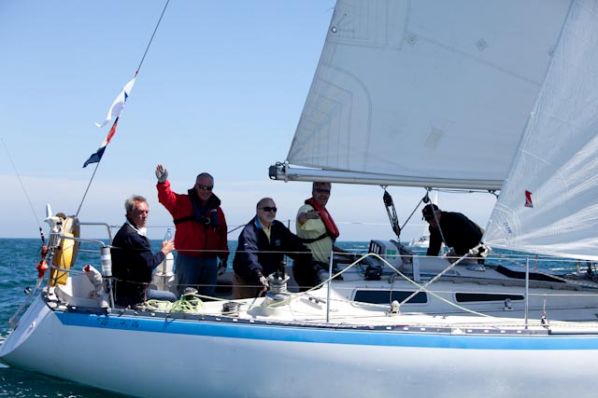
More on the Round Ireland Yacht Race:
Round Ireland Yacht Race 2010 Review
Round Ireland Yacht Race, Ireland's top offshore fixture
A Round up of 80 stories on the 2010 Round Ireland Yacht RaceNew Offshore Race Around Rockall
A new offshore race will set a fleet of boats on a sprint to Rockall, a lonely rock around 270 miles north-west of Donegal. The 750-mile race will be timed to coincide with the arrival of boats in the Volvo Ocean Race in Galway. The Round Rockall Race is the brainchild of Larry Hynes, who sailed around Ireland solo in 2005.
"We originally wanted to do it last in 2011," he said, "which was the 200th anniversary of the first landing on Rockall."
However, Hynes said that when he heard the VOR was coming back to Galway, it made sense to postpone the event to make it more palatable to travelling boats from France and elsewhere.
Hynes says he wants to keep the race 'fairly Corinthian' and is welcoming all comers. With Galway being twinned with Lorient in France, Hynes hopes to tap into the offshore sailing spirit of the French and tempt some French offshore boats north with the Volvo Ocean Race Fleet for the finish and a race in Irish waters.
The site already has a web presence, which puts many of the more established races to shame. He is working with former Round Ireland winner Aodhan Fitzgerald on a Notice of Race and says that he is steadfastly committed to running the event, whether he gets two or two hundred entries.
The Round Rockall website is at www.roundrockallrace.com
5,000 Sail from City Centre Slipway
More than 5,000 people hit the water with the East Wall Watersports Centre in the year 2009, according to centre principal Billy King. The centre, located in the Tolka Estuary in Dublin's East Wall, has a history of sailing in the area stretching back to the 1800s, but its new premises has allowed it develop a range of watersports over the last few years, with match racing among the items on the agenda for 2010.
The watersports group as it stands was formed in the 1980s with a group of people in the East Wall clubbing together to promote a variety of on-the-water activities. However by teaming up with Dublin City Council and sourcing lottery funding, and monies from the Docklands Development Authority and other groups, the new premises were built in 2007 and now house a fleet of dinghies and kayaks to cater for local school and business groups.
The centre has a new website at www.eastwallsailing.com, with Rory Walsh aiming to take participation to the next level and even encourage a match racing event at the end of the year, entitled the Docklands Challenge.
Says Rory: "Despite its discrete appearance (the building is earth bermed and can not be seen from the road or air) the building contains a boat shed, a workshop, changing rooms, a kitchen and a bright open plan teaching room, all of which have been fitted out to the highest standard"
Team Daft sponsorship formally announced
Property website Daft.com put its down payment on some prime publicity real estate today, formally announcing its plans to sponsor a boat in this year’s Round Ireland.
Daft will be backing blind adventurer Mark Pollock and Air Corps pilot Mick Liddy, the first double-handed crew with one blind member to compete in the Round Ireland Yacht Race.
The sponsorship deal will allow Liddy and Pollock charter a race-ready Class 40 for the event.
The announcement comes at a time when sponsorship deals for sailing individuals, never mind events, are at a premium. The Round Ireland Yacht Race itself has yet to secure a title sponsor, and other offshore sailors have struggled to retain sponsors or failed outright to raise funding for participation in higher-profile international events.
The motivation for Daft.com to come on board lies largely in the fact that Daft.ie is launching in the six counties of Ulster, making the company an all-island affair, which ties in nicely with a race around the island.
Said Pollock: “Securing a sponsor in these challenging economic times is very difficult and we feel extremely lucky to have the Daft brand behind us. For me, this competition is going to be the most challenging yet, as I will be operating the boat in two-hour shifts for the duration of the race. Unlike my previous challenges, I’ll be completely unguided. Having the support and backing of a sponsor like Daft.com means that I can focus entirely on the training and the race, knowing I have the Daft team right behind me.”
David Garland, Sales Director, Daft Media Group said, “I truly admire Mark as an individual and the manner in which he approaches every challenge he takes on. His commitment and determination to succeed is an inspiration to us all. We’re delighted to be in a position to be able to support and sponsor Mark and Mick in this high-profile sailing event.”
Cork Week: Cork Revealed, with Eddie English
Cork Week Revealed
with Eddie English (reprinted from Afloat 2006)

Eddie English stands high on Cobh’s historic waterfront and looks out across Cork Harbour, south towards Roche’s Point lighthouse and the entrance to the natural sailing sanctuary. Immediately below, a huge Brittany Ferries ship heads slowly out to sea; it’s not even close in size to a previous visitor to the former Queenstown, but then again, the RMS Titanic belonged to a different era.
To his left, the inshore waters north of the Whitegate oil refinery hide the channel to East Ferry where the Marlogue Inn stands over its marina and just opposite, the legendary Murphs on the mainland shore.
On his right, the channel between Spike and Haulbowline Islands and Cobh is the main shipping route for the Port of Cork for ferries, commercial shipping and the Irish Naval Service base.
But it’s the view straight out to sea that confirms one of the magic ingredients that have made Cork Week an international regatta of worldwide repute: vast tracts of open, unobstructed water and all within easy reach of the shoreside facilities of the hosts at the Royal Cork Marina at Crosshaven.
When it comes to local knowledge, few are as expert as English. Not only is he a former chairman of the event's racing committee, not only does he run a long-established sailing school in the harbour, but when you are offered an insight from someone who takes his dog for a walk on notorious mud banks at low water springs, they tend to be nuggets of the golden variety.
"The harbour course is the key to Cork Week," says English. "It's the decider where the event is won or lost and has the most variables involved." So this, then, is the Eddie English step-by-step guide to gaining an edge for that course, plus the coastal, wind/leeward and Olympic-type courses at Cork Week.
COPYRIGHT – AFLOAT MAGAZINE 2006
Cork Week and How You Can Win
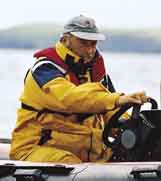 How you can win at Cork Week
How you can win at Cork Week
with more than a little help from local expert Eddie English [pictured left] – Cork Week 2004 (reprinted from Afloat July 2004). For all the up to date information and news on Cork Week click here.
Eddie English stands high on Cobh’s historic waterfront and looks out across Cork Harbour, south towards Roche’s Point Lighthouse and the entrance to the natural sanctuary. Immediately below, a huge Brittany Ferries ship heads slowly out to sea; it’s not even close in size to a previous visitor to the former Queenstown, but then again, the RMS Titanic belonged to a different era.
To his left, the inshore waters north of the Whitegate oil refinery hide the channel to East Ferry where the Marlogue Inn stands over its marina and just opposite, the legendary Murphs on the mainland shore.
On his right, the channel between Spike and Haulbowline Islands and Cobh is the main shipping route for the Port of Cork for ferries, commercial shipping and the Irish Naval Service base.
But it’s the view straight out to sea that confirms one of the magic ingredients that have made Cork Week an international regatta of worldwide repute: vast tracts of open, unobstructed water and all within easy reach of the shoreside facilities of the hosts at the Royal Cork Marina at Crosshaven.
When it comes to local knowledge, few are as expert as English. Not only is he chairman of the event's racing committee, not only does he run a long-established sailing school in the harbour, but when you are offered an insight from someone who takes his dog for a walk on notorious mud banks at low water springs, they tend to be nuggets of the golden variety.
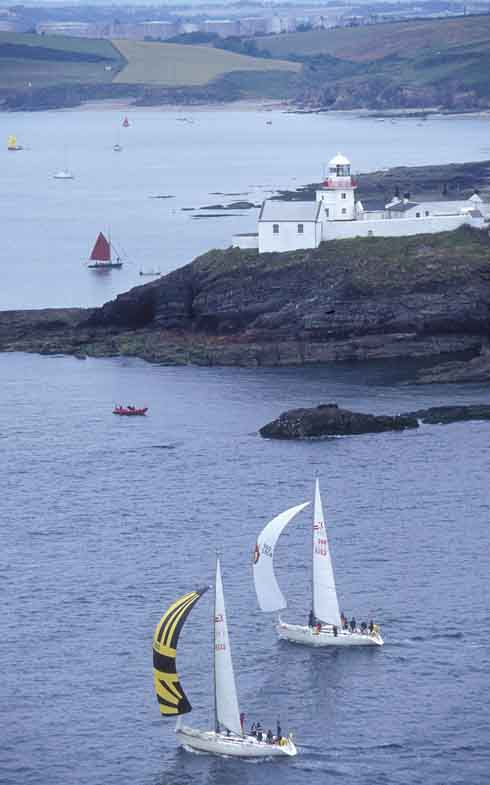
Left: Sigma 33s negotiate Roche’s Point
"The harbour course is the key to Cork Week," says English. "It's the decider where the event is won or lost and has the most variables involved." So this, then, is the Eddie English step-by-step guide to gaining an edge for that course, plus the coastal, wind/leeward and Olympic-type courses at Cork Week 2004.
Harbour Race
Above all, be conservative at the start of the Harbour Race if the tide is with you on the start off Weaver's Point. There can be two knots of tide here typically and an OCS in any fleet represents the end of the story with recovery improbable. Ideally, a short tour of the harbour during the weekend registration stage of Cork Week will pay dividends. If you can, borrow a RIB and take the tour at low-water.
Two marks form part of this course outside the harbour and rounding order will depend on wind-direction on the day. The first is off Ringabella to the south-west shore heading towards Kinsale. If there’s a flood tide, hug the shore. In fact, if the breeze is SW, go right, even in an ebb.
The second is off Trabolgan, east of Roche's Point. Crucially, beware of the strength of tide when traversing the channel across the harbour entrance. Don't just rely on the GPS – plot the tidal vectors to find the true course to steer. Once to the east of Roche's Point, there’s negligible tide and often a tide line can be observed.
This course then takes the fleet into the harbour but beware when entering on the east side of the Harbour mouth – the Cow and Calf rocks are extensions of Roche's Point up to one cable off the shore.
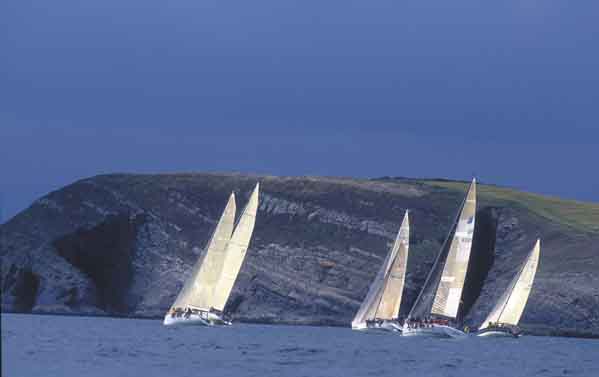
Above: Hugging the shoreline for a tactical advantage
Most races will come into a buoy east of Cobh, making this a long leg in, but offer plenty of hazards on a falling tide. After the Cow and Calf, it’s possible to dodge into White Bay but be wary of rocks and shallows on the south end of the bay close to Roche's Point.
The Dog's Nose promontory is next and it’s possible to cut into the area north of here though close inshore it shallows and the Black Rock is marked by a perch as the main hazard.
Bear in mind the sailing instructions that require clearance of 50 metres off the oil refinery jetty at all times. A listening watch on VHF Ch. 12 is useful for avoiding shipping.
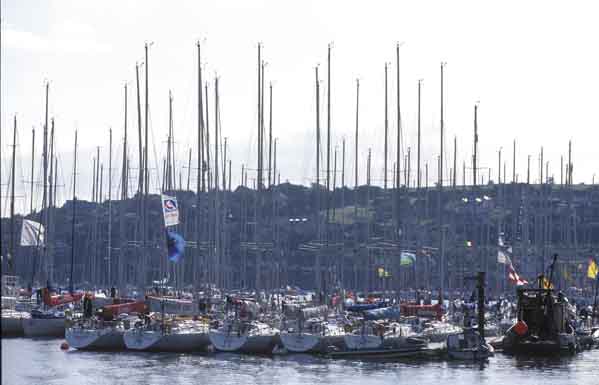
Above: The fleet at anchor – everyone’s gone to the pub...
Once past the refinery jetty, the tide running north-east/south-west for the East Ferry channel can suck you in or push you out.
The alternative to the eastern shore approach is to hug the western shore and involves rock-hopping from Ringabella in past Weaver's Point. An option is to duck into the Owenbue River at Crosshaven – the tide ebbs here up to 30–40 minutes before HW Cobh.
North of here, the Curlane Bank, south of Spike Island, offers an option but beware of shallows. The area south-east of Spike is littered with rocks and, in particular, off the eastern end is a large rock marked by a perch.
The Spit Bank is the biggest in the harbour and is located from the north end of Spike from the lighthouse to the corner off Haulbowline. On very low spring tides, football is played on this bank. The key here is: go as close as you dare. The bank is mostly mud except for ‘The Seven Stones’ aka The Ballast Rocks located approximately two cables east south-east of the No. 20 (Port) Buoy.
Having made the turn for the final approach to the Cobh rounding buoy, one of the showcase marks in the entire event set beneath the picturesque back-drop of the town, this leg from ‘Cuskinny Turn’ offers several options in tide. With the tide is a straight-forward matter of choosing the deepest water so check the charts. Usually, the north shore offers no significant gains. Keep a sharp watch for the passenger ferries running from Cobh to Spike and Haulbowline Islands.
From Cobh, the Harbour Race will have a new finishing line in 2004, moving to the No. 7 (starboard) buoy south of the refinery.
Coastal Course
Going west from the start in a south-westerly or filling sea-breeze, taking the right-handside of the course, pays off, thanks to lifts off the shore. Use the bays to get out of the tide, with the exception of the first bay after Robert's Head/Daunt buoy – it’s called Rocky Bay and it is!
The tide here follows a south-west/north-east direction in line with the heads with a one-knot maximum. Keep the harbour entrance strategy from the previous course notes in mind too.
For 2004, the former south-east mark located approximately three miles east of Roche's Point has been renamed Moonduster as a tribute to the late Denis Doyle and his legendary 51-foot yacht that is synonymous with Cork.
All Courses
The Olympic and windward/leeward are located outside the harbour so allow plenty of time to get afloat – some courses could take you up to an hour to reach as the number of yachts leaving Crosshaven at one time can mean congestion. The furthest course is three miles south-east of Roche's Point which in turn is two miles from Crosshaven. Don't assume the Race Officers will wait – best advice is to follow the professionals' example and leave early to be at sea on time with an opportunity to practice a few crew drills.
These courses usually have no significant tidal factors as most are located outside the harbour and beyond the main entrance tide line. More importantly, if a sea breeze builds, this will be of more use to you.
If a sea-breeze applies, it generally tends to build from around 11am, peaks at 3pm and is gone by 6pm. It will usually begin in the south/south-east provided the gradient doesn't block it. It tends to veer throughout the day until it comes from the SSW to SW – always moving right as the day progresses. Be vigilant to spot it building as it applies to all courses.




























